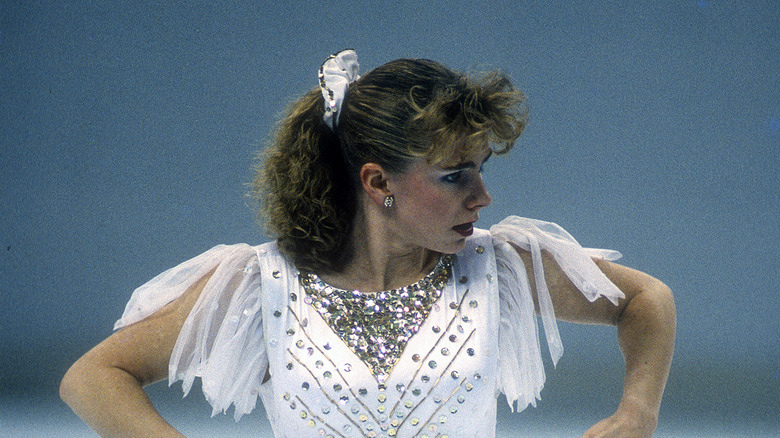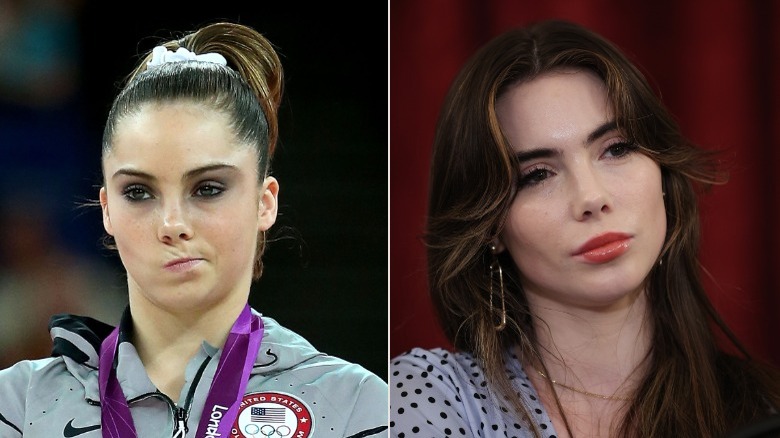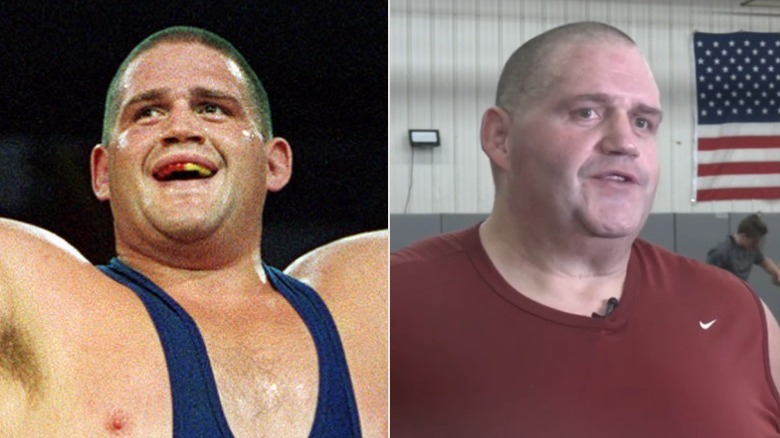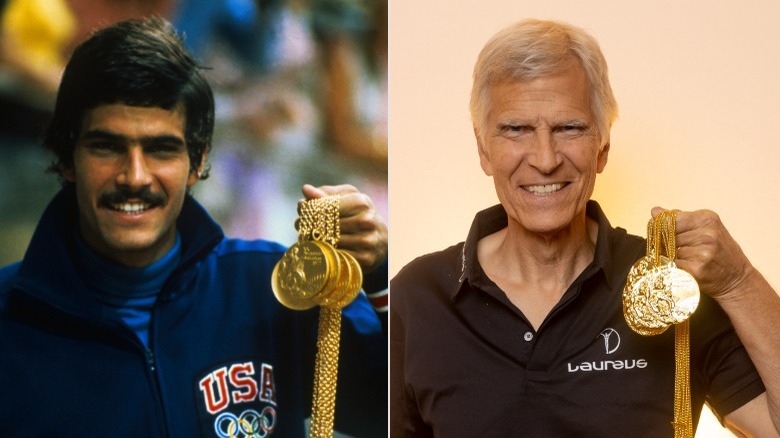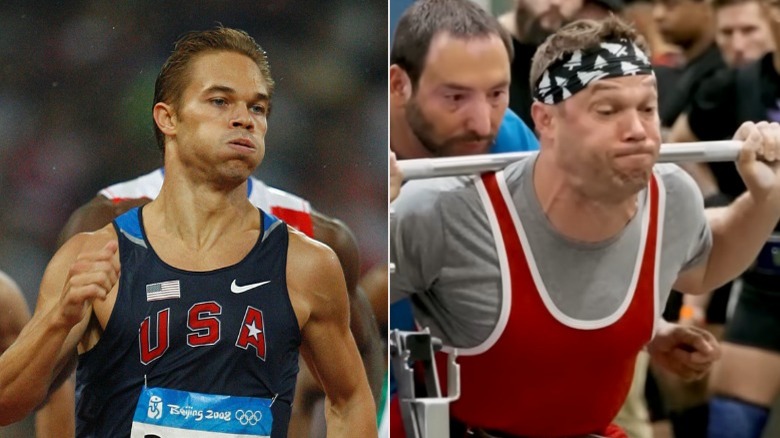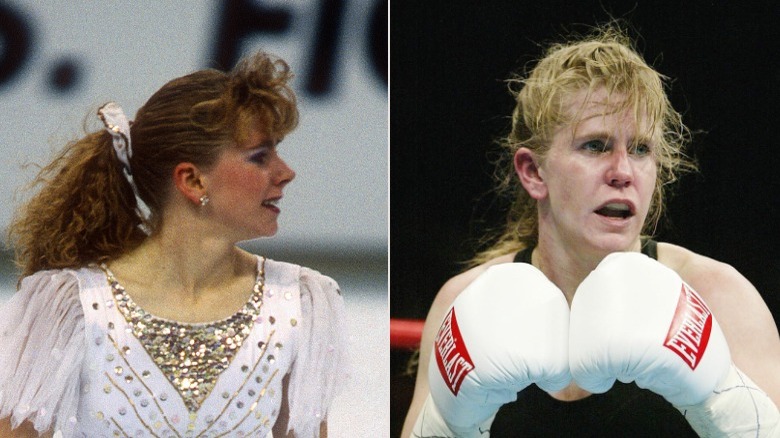Olympic Athletes Who Look Nothing Like They Used To
If there's a single athletic event that needs no introduction, it's the Olympics. Many athletes have cemented their place in history at the Games, with names such as Simone Biles, Michael Phelps, and Usain Bolt now immortalized. To both hardcore fans and casual viewers alike, the most famous of Olympic athletes are globally recognized. That said, though, the nature of athletic fame means that plenty of fans may only remember those competitors as they looked at the height of their Olympic successes.
At their peak fitness, billions watch Olympic athletes beaming from the podium with medals in hand or sporting their country's colors. But the lives of those athletes extend far beyond their presence at the Olympics, and, well after the Games have finished, their current appearances might not be exactly what you're used to. Just like other athletes who don't look like they used to, here are a few Olympic athletes whom you may find hard to recognize today.
McKayla Maroney
As of 2024, women's artistic gymnastics has pretty well and truly captivated the world, and the U.S. team has been especially indomitable. However, there was once a 16-year gap in gold medal wins for the U.S. team, following the 1996 successes of the women's gymnastic team now known as the Magnificent Seven. That changed in 2012 with the Fierce Five, with U.S. gymnasts Gabby Douglas, Jordyn Wieber, McKayla Maroney, Aly Raisman, and Kyla Ross together winning gold for their nation.
But in the meme-filled internet, Maroney unexpectedly became something of a breakout star, and anyone who watched gymnastics at the London Olympics probably remembers why: her unimpressed expression after she placed second in the vault finals, after losing out on the gold due to a fall. Maroney was genuinely disappointed in herself and wanted to make a comeback, but she ultimately retired a few years later due to health issues.
Instead, Maroney overcame her life's tragedies and began building out a diverse career that now includes singing, songwriting, acting, writing, and advocacy. Quite the change, and with it came a very new look — one which led to some rumors of lip injections or cosmetic surgery. Maroney denied those rumors, explaining that she simply started getting into makeup and fashion after her gymnastics career, and her body was just naturally changing. As she told Seventeen: "I think it freaks people out to see somebody change just a little bit. I don't mean to freak anybody out. At the end of the day, I have changed ... It's good to keep evolving and growing."
Rulon Gardner
For those in need of a good underdog story, you need look no further than the "Miracle on the Mat," which refers to the Greco-Roman heavyweight wrestling final in the 2000 Olympics. There, American Rulon Gardner was pitted against three-time Olympic gold medalist Aleksandr Karelin of Russia. Gardner's odds were far from great, to say the least, but he managed to pull off a huge upset victory and come out of the Games with a gold medal.
Off of the mat, though, Gardner's life wasn't looking quite as smooth. There were a couple of brushes with near-fatal accidents and bankruptcy, and following his last appearance at the 2004 Athens Olympic Games, Gardner had gained well over 200 pounds, weighing in at a total of 474 pounds in 2011. That year, he was announced as a contestant on "The Biggest Loser," where he lasted for 16 weeks and lost 173 pounds, only to suddenly pull out of the competition. Gardner has spoken about being treated unfairly on the show, but has also said that an NDA has kept him from going into any of the details.
Over the following decade, Gardner continued to make efforts to rejoin the wrestling scene, but he missed weigh-ins by being too heavy to compete, and as of 2020, he was back to being nearly 500 pounds.
Mark Spitz
Before Michael Phelps, U.S. star Mark Spitz was the biggest name in Olympic swimming. Representing the U.S. in both the 1968 Mexico City and 1972 Munich Olympics, Spitz etched his name into the annals of history by setting record after record in Munich. One of those was the record for the most gold medals won at a single Olympics, with Spitz returning from the Munich Games with seven golds. It wasn't just his athletic ability that stuck with people: Spitz's mustache made quite the impression, too.
Spitz's mustache was iconic, and he's admitted to leaning into that. In fact, he'd grown the mustache for no particular reason, initially intending to shave it off before the competition. But Olympic swimmers didn't typically sport facial hair, and Spitz found that his competitors were fascinated. Some Russian coaches even questioned him about it, and he made the impulsive decision to keep it. Not only that, but he doubled down on his act, claiming, "This moustache deflects the water away from my mouth ... it allows me to swim faster" (via the International Olympic Committee website). Apparently, the Russian swimmers were sporting mustaches of their own the following year.
Spitz doesn't have the iconic mustache anymore, though. When asked why he shaved it off in 1988, he explained, "Well, one, I'm not swimming anymore. And No. 2, it started to turn gray. And No. 3, my wife had never seen me, nor my family, without the mustache. I haven't had it for 20 years, so I'm happy" (via Newsday).
Nick Symmonds
As a runner, two-time Olympic sprinter Nick Symmonds knew how to get lean for competitions. But since retiring from the track after his appearances in the 2008 and 2012 Olympics, Symmonds has shifted his interests, so his body has changed quite a bit, too.
Symmonds has spoken about those physical changes, explaining that he started really hitting the gym and lifting weights regularly after retiring from professional competition. As a result, he built up a significant amount of muscle mass that left him feeling healthier than he ever had been as a runner. Beyond that, he also took an interest in powerlifting competitions, and for that, he felt he needed to bulk up even further. And so his initial solution to that? Just eating. A lot. Figuring that having more mass would allow him to lift more weight, he let himself eat whatever he wanted, but Symmonds later refined his approach to simply gaining as much muscle as possible. The routine has landed him with a physique considerably more muscular than the one he had as a runner.
Tonya Harding
If you're familiar with Olympic ice skating, then you've almost certainly heard of one particular Olympic athlete who might have taken things too far: Tonya Harding, a very powerful and impressive skater back in the 1990s, and who competed in the 1992 and 1994 Olympics. Despite her technical ability, she craved the commercial fame that her rival, Nancy Kerrigan, was receiving. To Harding, the only way to manage that was to win gold at the 1994 Games, and the best way to do that was to eliminate the competition. Harding's then-husband hired someone to attack Kerrigan and keep her from qualifying for the Games — pretty messed up, even for the Olympics. The plot was discovered, and Harding's reputation never fully recovered.
She did, however, pivot into a different sport, and one very different from ice skating: boxing. Granted, this was back in the early 2000s — nowadays, she's mostly living a quiet life — and her career as a professional boxer was relatively short, but it was still a far cry from the elegance and sparkling outfits seen on the ice.
Harding's first match took place in 2002 — a celebrity match-up that she won, which caught the public eye and led her to officially go pro by the next year. And though she was far from the best at the sport, promoters noted that she was impressively tenacious, strong, and trained incredibly hard, putting her all into the new sport.
